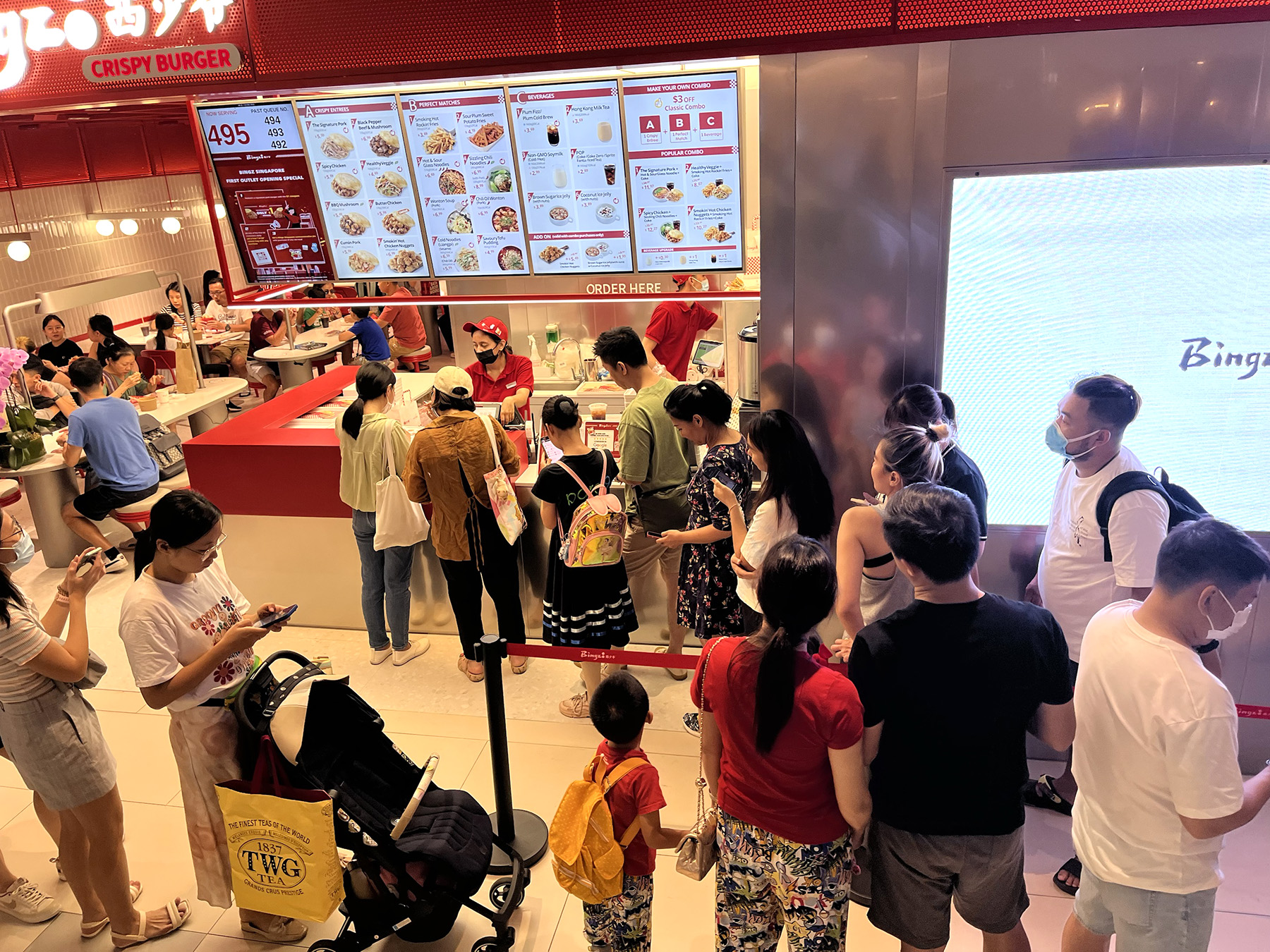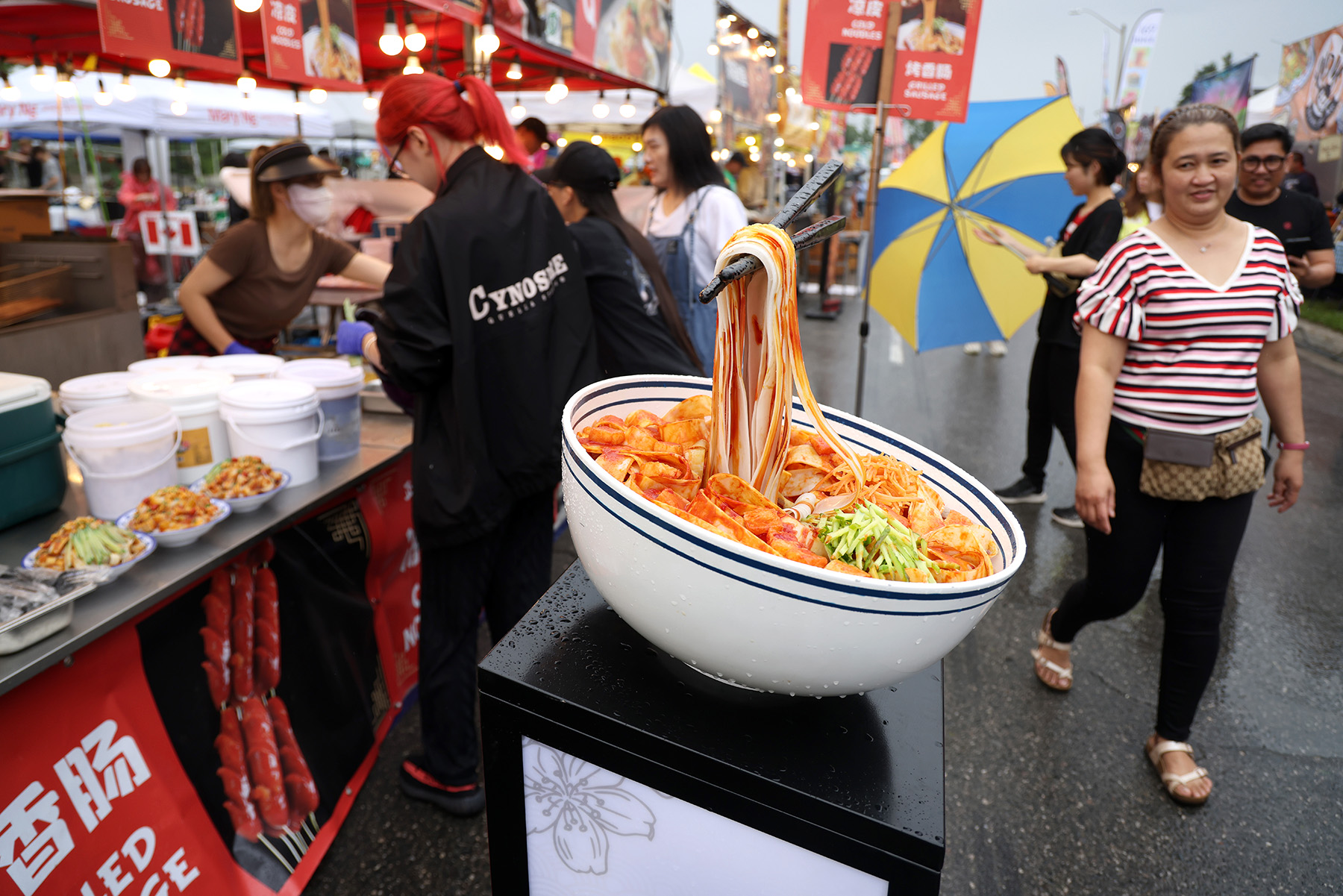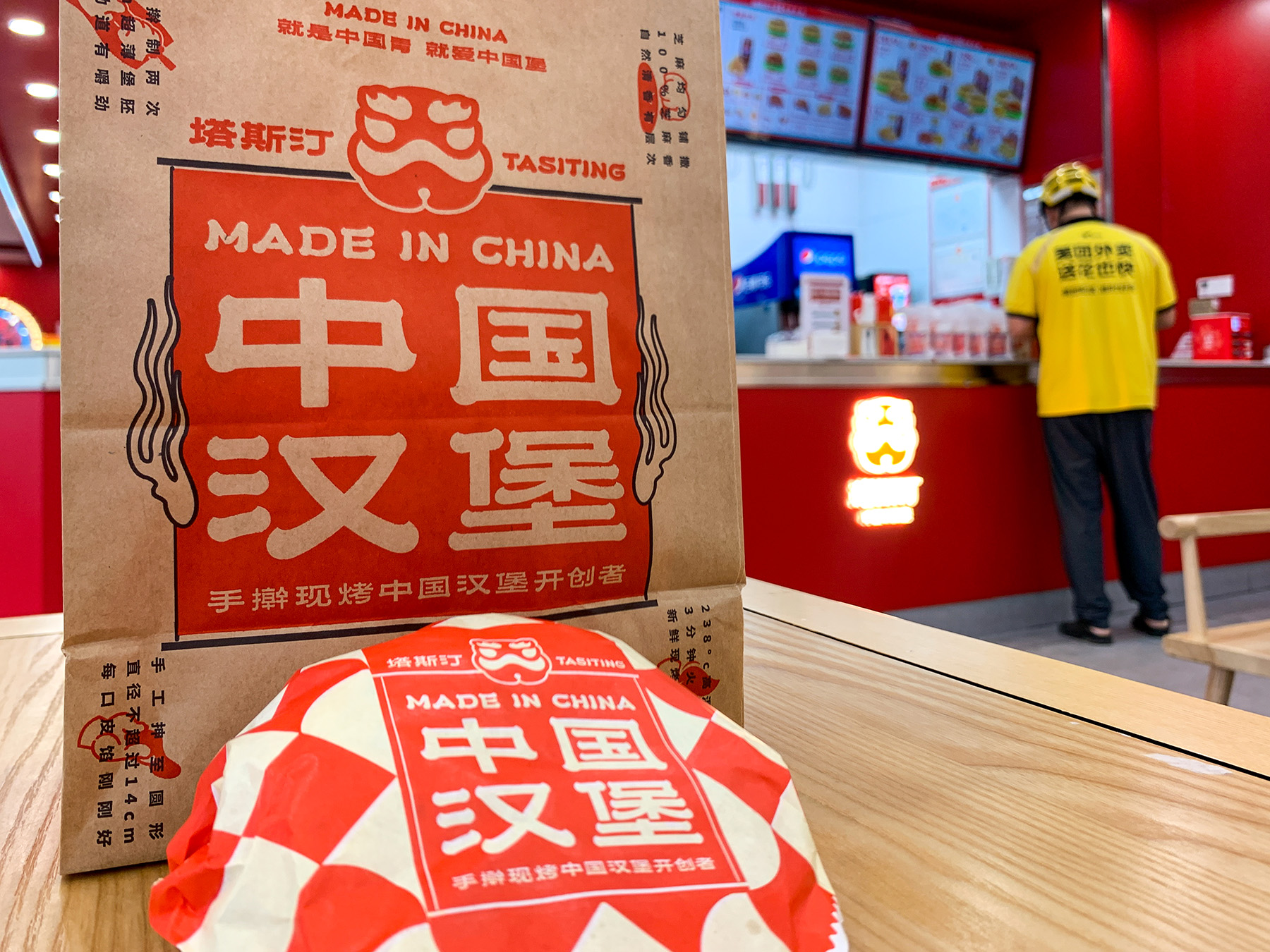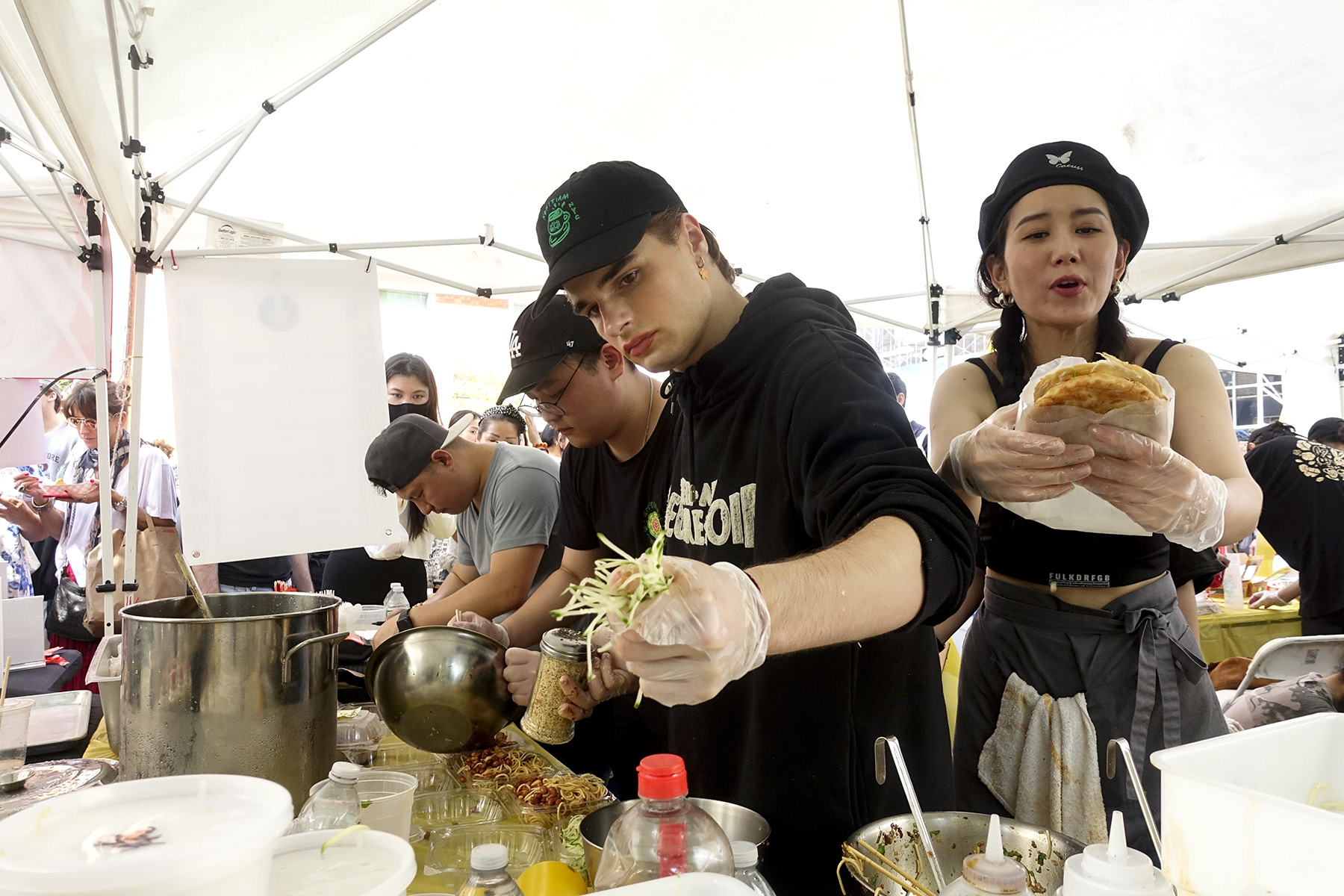Demand for Chinese fast food fuels rise of chains offering meals steeped in tradition

Wrapped in a bright red cape, with a horn, round belly and starry eyes under flame-shaped eyebrows, Ta Lion has become a beacon for a new generation of China’s fast-food lovers.
Ta Lion is the brand ambassador for the Tastien burger chain.
Since its establishment in 2012, Tastien, also known as Tasiting, has quickly spread to over 7,000 locations across the nation, serving up Chinese-style burgers that stand out for their hand-rolled, freshly baked buns.
Their offerings blend Western-style burgers with traditional Chinese flavors, offering choices such as Peking duck, garlic pork and Mapo tofu. At the end of March, Tastien launched a cumin-flavored duck burger, which has been a hit with customers.
Wang Ping, a 43-year-old Beijing resident, said: “I had my first taste of their burger when I was very hungry and had no other fast-food choice in the neighborhood. It turned out to be juicy and full of flavor. I have been buying them ever since then.”
The rise of Tastien is part of a broader boom in Chinese fast food, with chains like Liao Xiang Ji and Micun Banfan expanding rapidly. Some, like Bingz, have seen success abroad, challenging global giants and eyeing markets like the United States.
This trend reflects a growing appetite among young consumers for fast food that incorporates Chinese culinary traditions and ingredients, driven by a renewed interest in cultural heritage.
Tastien, in particular, embraces Chinese cultural elements not only in its menu, but also in its branding and store design, combining traditional motifs with a modern aesthetic.

During the Spring Festival, Tastien teamed up with reality show National Treasure to introduce a special “Treasure Basin” set meal. Inspired by a lacquered carved box, an item once used by royalty for storing valuables or food, the meal symbolizes wealth and prosperity.
On its official WeChat account, Tastien collected ideas for co-branding from netizens, with posters suggesting it could collaborate with the Palace Museum and domestic comics like The Grandmaster of Demonic Cultivation to promote traditional culture.
Meanwhile, even Western fast-food chains in China are weaving Chinese cuisine into their offerings, from youtiao (deep-fried dough sticks), tea eggs and porridge at KFC to pickled vegetable and bamboo-shoot chicken porridge and soy milk at McDonald’s, highlighting a wider trend of cultural fusion in the fast-food industry.
Chen Yong, an associate professor at EHL Hospitality Business School in Switzerland who focuses on tourism and hospitality marketing and economics, sees quick service, efficiency and affordability as key to the fast-food industry’s high customer return rate. For fast-food chains, this means expanding their presence with more outlets is essential for accessibility, Chen said.
He believes China’s vast catering market is ripe with opportunities for Chinese fast-food brands, especially since Western fast food has already paved the way for demand among Chinese consumers.
A January report by the World Federation of Chinese Catering Industry highlighted that young people, particularly students and young professionals aged between 18 and 24, are the backbone of food consumption, valuing cost-effectiveness and convenience above all.
This demographic is also the primary customer base for fast food, influenced by their income, expenditure, and a preference for a fast-paced lifestyle encouraged by short-video platforms, Chen said.
Lao Xiang Ji, a chain with over 1,000 locations nationwide, is rapidly expanding to meet the demands of these young consumers. Known for its quick-serve chicken dishes, Lao Xiang Ji has tapped into health trends by collaborating with Boohee Health to launch a fat-reduced menu, in line with the popularity of the movie You Only Live Once and a growing consumer preference for low-calorie options.

They even introduced a “Nutritionist Recommended” section on their mini app, complete with calorie counts for each dish. This initiative has been well received online, with social media users launching challenges like the “14-Day Lao Xiang Ji Eating Challenge”.
Chen believes that for Chinese fast-food chains to continue growing and to compete with Western fast food, they must maintain their price advantage, ensure the quality of their dishes, and gradually increase their coverage area.
China’s domestic fast-food brands are relatively young, he noted. “Chinese entrepreneurs should have a vision to ensure their Chinese fast-food brands still exist 20 to 30 years from now,” Chen said. “These emerging brands should strive to explore business models, products, and services that are better than their competitors.”
Chen hopes that Chinese catering brands will consider the global market in their development plans for the future. “Chinese culinary culture is among the best in the world. Foreign tourists who come to China and want to try Chinese food would also be willing to try Chinese fast food,” Chen said. “By providing good products and services, coupled with the advantage of pricing, we can also offer a great experience for foreign tourists.”
According to the 2023 Snack and Fast Food Category Development Report by the Hongcan Industry Research Institute, the market surpassed 80 trillion yuan ($11.25 trillion) by the end of 2023, with over 4 million snack and fast-food outlets nationwide. About 30 percent of brands have over 50 outlets, and 2.9 percent have more than 500.
Chinese snack and fast-food options are diverse, including noodles, rice dishes, buns, dumplings, wontons, pancakes, and porridge. Typically, Chinese cuisine offers a wide range of flavors and involves complex cooking processes, which can be a challenge for standardization compared with Western fast food. However, Chinese fast-food chains are finding ways to adapt.
For Wang Guoyu, founder of Nan Cheng Xiang in Beijing, efficiency is crucial in the food industry. With over 200 outlets, Nan Cheng Xiang earned 1.5 billion yuan in revenue last year, setting a benchmark for fast-food efficiency. Each outlet generates about 10 million yuan annually, which is five to ten times the industry average.

Nan Cheng Xiang mainly operates as a community canteen in residential areas, offering all-day service and a cost-effective menu. For instance, the average amount spent on lunch is around 30 yuan, which attracts regular customers such as parents with children, and seniors.
A notable aspect of Nan Cheng Xiang’s strategy is its exclusive focus on Beijing for the past 21 years, without franchising, financing, IPO plans, or advertising. Instead, it relies on word-of-mouth and the appeal of its outlets. Wang believes that expanding the company’s footprint in Beijing is more effective than spending on ads.
Unlike mall-based outlets, community stores have flexible operating hours, opening from 6 am to 10 pm to maximize revenue. Wang said that rent and labor are the major cost factors in Beijing’s food industry, and full-day operations require careful management.
To enhance efficiency, Nan Cheng Xiang continuously adjusts kitchen layouts and streamlines processes. They employ a unique organizational structure, known as the “UFO-shaped model”, which eliminates middle layers and enables direct communication between the headquarters and outlets. The team at headquarters is kept lean, with just over 30 staff members.
Efficient ingredient sourcing and distribution are also priorities for Nan Cheng Xiang. Besides their central kitchen in Daxing district, they are building another one, Wang said. Vegetables are processed at their factory in Hebei province, 60 kilometers from Beijing, and delivered to stores ready for cooking.
Selecting prime locations in communities can be challenging due to limited availability. Nan Cheng Xiang’s site selection team uses digital tools and on-site inspections to make informed decisions. “However, securing desired locations often requires patience, with waiting times of up to two to three years,” he said.
Nan Cheng Xiang’s outlets also undergo daily adjustments based on market trends and efficiency improvements.
Micun Banfan, a brand specializing in authentic Korean cuisine from Yanji, Jilin province, has recently become the new favorite of working people. Founded in 2014, it now boasts 1,000 stores and is nicknamed the “Northeast McDonald’s”.

In its kitchen, customers can witness the preparation process as staff pour pre-prepared ingredients onto an iron plate, and heat and mix them with a pre-prepared sauce before serving a sizzling dish.
Despite some reservations about pre-prepared dishes, Micun Banfan’s use of quality ingredients and affordable pricing (around 20 yuan) has earned it the title of “the favorite work meal of working people” on social media. Served in steaming stone pots with specially made protective paper to prevent splashes, it creates a different dining experience.
Zhou Ning, general manager of Yanbian Micun Catering Management Company, said the brand’s mission is to offer great food at a reasonable price. In 2021, its traditional Korean cooking techniques were recognized as an intangible cultural heritage in Jilin. That same year, Micun Banfan moved its headquarters to Shenyang, capital of Liaoning province, and introduced a partner system to implement its expansion.
Under the system, partners, store managers, master chefs, regional managers, and site selection teams share the benefits and risks together. This approach allows the brand to expand without shouldering all the operating costs.
“We continuously refine our partner mechanism to ensure mutual success,” Zhou said. “Our regional managers support store managers, focusing on customer satisfaction and maintaining our brand’s reputation.”
Micun Banfan uses a structured training system for its staff, with the aim of fostering a culture of continuous improvement and passing on knowledge.
Competitive pricing stands out as a feature of Chinese fast-food chains. Bingz, a Chinese fast-food chain famous for its roujiamo meat burgers, decided to slash prices in early 2023. Some dishes like the chicken bone spicy and sour noodles dropped from 15.75 yuan to just 9.9 yuan for a limited time.
Founder Meng Bing said market research highlighted the importance of offering value for money. “We’ve noticed a shift away from impulsive spending to a more practical mindset, where people want quality products and services for their money,” Meng said.
At the end of last year, Bingz opened a new factory in Leling, Shandong province. The factory processes noodles for the global market and meat products for domestic tastes.

Bingz sources ingredients globally to ensure quality and affordability. “Our restaurants are adopting a low-margin, high-volume sales strategy, moving away from high prices to attract more customers,” Meng explained.
Currently, Bingz has about 200 stores across China, spanning 13 cities including Beijing, Shanghai, Tianjin, and Guangzhou, Guangdong province. This year, Bingz plans to expand to more provincial capitals, aiming to surpass 500 stores by the year’s end.
In 2021, Bingz opened its first international restaurant in Toronto, Canada. Today, Bingz operates five stores in Ontario province, with a single outlet’s annual revenue exceeding 20 million yuan, outperforming established brands like Burger King, Starbucks, and Subway, Meng said.
The menu favorites in Canada include the Signature Beef Burger, Black Pepper Beef Burger, Butter Chicken Burger, Plum Fizz and Cold Noodles Salad.
New restaurants are set to open in British Columbia later this year, with Bingz aiming for a total of 15 restaurants by the end of 2024, Meng said.
The success in Canada has encouraged Bingz to enter the United States market. A central factory is being built in San Diego to serve North America, with plans to open 10 restaurants in California by the end of 2025.
Bingz currently employs over 300 people in Canada and the US, with the number expected to grow to nearly 1,000 by the end of the year. “The US is seen as Bingz’s biggest market outside China, with a target of 3,000 restaurants introduced in multiple five-year phases,” Meng said.
The first five-year phase includes opening 300 restaurants with anticipated annual revenues of $4 million to $6 million.
Last year, Bingz also launched in Singapore, and rapidly became popular. Meng does not view Singapore as a market but as a regional hub for Southeast Asia, with plans to open more than 50 restaurants in the city.
Its Singapore restaurants have also attracted customers from Malaysia and Indonesia, particularly for the chain’s Butter Chicken Burger, Sizzling Chili Noodles, and Hong Kong Milk Tea.
Meng intends to extend Bingz’s reach into Japan, Australia, and the United Kingdom in the near future, with the aim of entering 20 countries within three years. Packaged food products from Bingz are scheduled to launch in the second quarter of this year, targeting swift entry into the global market through offline channels like Costco and Walmart, as well as online platforms such as Amazon and Shopee.
Established in 2014, Bingz has experienced significant growth over the past decade. Meng’s vision for the next five years is to see Bingz emerge as a globally influential multinational chain and a distinguished ambassador of Chinese culture.


